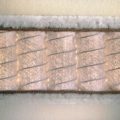Design: Alexandra Kosobokova. Photo: Dmitry Korolko Retro decor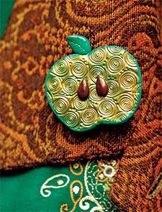 How to make jewelry with your own hands Materials:
How to make jewelry with your own hands Materials:
- Black plastic for modeling Soft series Fimo (manufacturer - Eberhard Faber, Germany)
- Pigment in the form of silver and dark pearlescent powder Pearl Ex (manufacturer - Jacquard Products, USA)
- Transparent varnish for plastic coating (manufacturer Eberhard Faber, Germany)
- Beads of gray and dark crimson color
- Nylon coated metal line (length about 70 cm)
- Lock and ring, four crimp, pin
Tools: Button with a convex pattern, a special knife for plastic or a scalpel, foil, baking parchment, thin drill, nippers, pliers, round pliers
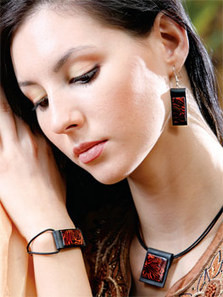
 Description of work1. Making a stamp.Choose a base from which you will copy the relief. For example, a brooch, a coin with an original convex pattern or, as in our case, an oval button. Soften a piece of plastic with your fingers, roll a ball, making it slightly flattened. Press the button to it and press it with your fingers so that some of the plastic comes out beyond its edges. To make the stamp durable and larger than the future decoration, there should be enough plastic. 2. Separate the button by pulling it with your fingers or hooking it by the loop with a knitting needle. Take it out carefully, gradually separating the plastic along the edges so that the pattern does not deform. Place the stamp on parchment and place in the oven preheated to 130 °C. For a product made of Soft plastic of the Fimo series, 5 mm thick, it will take about 27 minutes. When this time has passed, take out the stamp and press it lightly with your finger – If the plastic springs back, return it to the oven for another 1-2 minutes. You can lower the temperature to 70 °C. After the oven, the plastic will become matte and very elastic. When the stamp cools down, it will harden. 3. Making a pendant. Take a smaller piece of plastic. Knead it with your fingers, roll it into a ball. Place it on the stamp and press it with your fingers. Carefully remove the future pendant from the stamp, trying not to damage the relief.
Description of work1. Making a stamp.Choose a base from which you will copy the relief. For example, a brooch, a coin with an original convex pattern or, as in our case, an oval button. Soften a piece of plastic with your fingers, roll a ball, making it slightly flattened. Press the button to it and press it with your fingers so that some of the plastic comes out beyond its edges. To make the stamp durable and larger than the future decoration, there should be enough plastic. 2. Separate the button by pulling it with your fingers or hooking it by the loop with a knitting needle. Take it out carefully, gradually separating the plastic along the edges so that the pattern does not deform. Place the stamp on parchment and place in the oven preheated to 130 °C. For a product made of Soft plastic of the Fimo series, 5 mm thick, it will take about 27 minutes. When this time has passed, take out the stamp and press it lightly with your finger – If the plastic springs back, return it to the oven for another 1-2 minutes. You can lower the temperature to 70 °C. After the oven, the plastic will become matte and very elastic. When the stamp cools down, it will harden. 3. Making a pendant. Take a smaller piece of plastic. Knead it with your fingers, roll it into a ball. Place it on the stamp and press it with your fingers. Carefully remove the future pendant from the stamp, trying not to damage the relief.
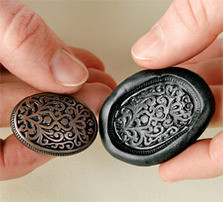
 4.Wrap the button in foil and insert it into the pendant from the back. Use a special knife for plastic or a scalpel to trim off any excess plastic along the edges of the button. Press down any uneven areas along the edge of the pendant with your fingers. 5. Open the jars with pigment powder without shaking them. Collect the powder that remains on the lid with your finger and run it over the surface of the pendant. Make sure that the powder does not "fall" into the patterned recesses. First apply the silver pigment, leaving a few free spaces, then cover them with dark mother-of-pearl so that the pendant "shimmers". Take out the button. Make a small oval cushion out of foil in the shape of a button. Place it under the product before firing so that the pendant does not sag. Place in an oven preheated to 130 °C for 25-27 minutes. Let the product cool. Take a thin drill and make a small hole with it to later attach a ring to the pendant. 6. Cover the pendant with a special varnish for plastic. Let it dry for 20 minutes. Cover it with a second coat. Bite off the head of the pin with nippers and bend it into a ring. Thread it into the hole in the pendant. Take a fishing line and string dark crimson beads on it, then put on two clamps (crimps) and a ring. Bend the fishing line in the opposite direction and thread it through the clamps put on it. String gray beads on the free end. Thread the two resulting bead threads through the ring on the pendant. Align the two ends of the fishing line and put two clamps on them, then a lock. Bend the ends back and thread them through the clamps. Squeeze all four ball-locks with pliers to prevent them from slipping. Use wire cutters to cut off the remaining line.
4.Wrap the button in foil and insert it into the pendant from the back. Use a special knife for plastic or a scalpel to trim off any excess plastic along the edges of the button. Press down any uneven areas along the edge of the pendant with your fingers. 5. Open the jars with pigment powder without shaking them. Collect the powder that remains on the lid with your finger and run it over the surface of the pendant. Make sure that the powder does not "fall" into the patterned recesses. First apply the silver pigment, leaving a few free spaces, then cover them with dark mother-of-pearl so that the pendant "shimmers". Take out the button. Make a small oval cushion out of foil in the shape of a button. Place it under the product before firing so that the pendant does not sag. Place in an oven preheated to 130 °C for 25-27 minutes. Let the product cool. Take a thin drill and make a small hole with it to later attach a ring to the pendant. 6. Cover the pendant with a special varnish for plastic. Let it dry for 20 minutes. Cover it with a second coat. Bite off the head of the pin with nippers and bend it into a ring. Thread it into the hole in the pendant. Take a fishing line and string dark crimson beads on it, then put on two clamps (crimps) and a ring. Bend the fishing line in the opposite direction and thread it through the clamps put on it. String gray beads on the free end. Thread the two resulting bead threads through the ring on the pendant. Align the two ends of the fishing line and put two clamps on them, then a lock. Bend the ends back and thread them through the clamps. Squeeze all four ball-locks with pliers to prevent them from slipping. Use wire cutters to cut off the remaining line.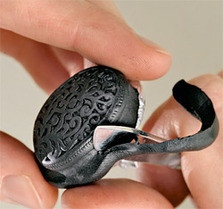
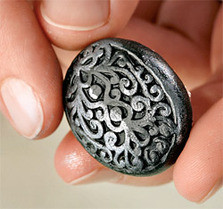
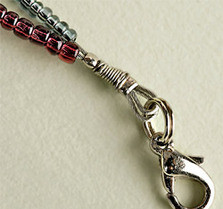 Dictionary
Dictionary
- Crimp is a metal fastener in the form of a small ring, a clamp for beads.
- Pin (from the English pin - pin) - a soft short wire, may have a ring at the end.
Tip
- In this master class Soft plastic was usedFimo series. This series also includes Classic plastic. Soft is more elastic and easier to knead, so it is often used to make miniature jewelry, and Classic is for larger items. Plastic from other manufacturers is available for sale. For example, Cernit (Germany). It is suitable for imitation, since after firing it retains a slight gloss and creates a transparency effect.
- To prevent plastic from sticking to your hands andTo avoid leaving fingerprints on the product, lightly rub your fingertips with fine pumice before work. And to prevent the soft mass from sticking to the button and stamp, let the plastic lie without packaging for about 40 minutes.





